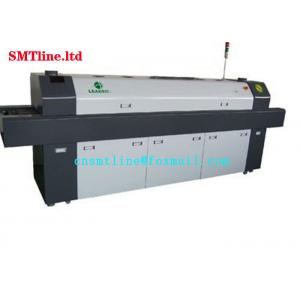
Add to Cart
cnsmt Cheap price SMT Reflow Oven for PCB and led borad Soldering factory direct sale
Feature
| Product Name: | SMT Reflow oven |
| Used for: | SMT FULL LINE |
| Warranty: | 1 Year |
| Shipment | by air |
| Delivery Time: | 1-2Days |
| Our Main Market | Whole of the world |
Application
Affecting process factors
The reasons for the uneven heating of the components caused by the SMT reflow soldering process are: the difference in heat capacity or heat absorption of the reflow components, the influence of the belt or heater edge, and the load of the reflow soldering product.
1. In general, PLCC and QFP have a larger heat capacity than a discrete chip component. Welding large area components is more difficult than small components.
2. In the reflow oven, the conveyor belt is used to reflow the product during recirculation, and it also becomes a heat dissipation system. In addition, the edge of the heating part is different from the central heat dissipation condition, the general temperature of the edge is low, and the temperature in the furnace is divided by each temperature zone. Different requirements, the same temperature of the carrier surface is also different.
3. The effect of different product loadings. The adjustment of the temperature profile of the reflow soldering shall take into account good reproducibility with no load, load and different load factors. The load factor is defined as: LF = L/(L+S); where L = length of the assembly substrate and S = spacing of the assembly substrate.
The reflow process results in reproducible results. The larger the load factor, the more difficult it is. Usually the maximum load factor of the reflow oven ranges from 0.5 to 0.9. This depends on the product condition (component soldering density, different substrates) and the different models of the reflow furnace. To obtain good welding results and repeatability, practical experience is very important.
Folding this paragraph welding defects
Folding bridge
Solder sagging occurs during soldering heating. This occurs in both preheating and main heating. When the preheating temperature is in the range of tens to a hundred, the solvent, which is one of the components in the solder, will reduce the viscosity. Outflow, if the outflow trend is very strong, the solder particles will also be extruded out of the solder area to form gold-containing particles. If they cannot be returned to the soldering area during melting, they will form stagnant solder balls.
In addition to the above factors, whether the end electrodes of the SMD device are well-formed, whether the circuit board layout design and the pad pitch are standardized, the selection of the flux application method, and the coating accuracy thereof are the causes of bridging.
Folding monument
Also known as the Manhattan phenomenon. Discrepancies occur when the chip components are subjected to rapid heating. This is due to the temperature difference between the two ends of the rapid heating element. The solder on one side of the electrode is completely melted and obtains good wetting, while the other side of the solder is not completely melted and causes wetting. Bad, this promotes the uplift of the components. Therefore, from the point of view of time elements when heating, a horizontal temperature distribution is formed in order to avoid the formation of rapid heat.